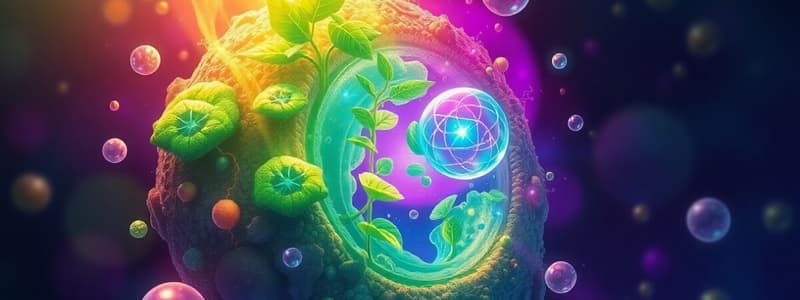Podcast
Questions and Answers
What is endocytosis?
What is endocytosis?
- The process by which a cell expels materials
- The breakdown of glucose into pyruvate
- The phase where the cell prepares for division
- The process by which cells bring materials into themselves (correct)
Aerobic respiration occurs in the absence of oxygen.
Aerobic respiration occurs in the absence of oxygen.
False (B)
What is the primary function of ATP in cells?
What is the primary function of ATP in cells?
To carry energy
The reactions that occur in the thylakoid membranes of chloroplasts that require sunlight are known as __________ reactions.
The reactions that occur in the thylakoid membranes of chloroplasts that require sunlight are known as __________ reactions.
Match the following terms with their descriptions:
Match the following terms with their descriptions:
Which of the following statements about autotrophs is true?
Which of the following statements about autotrophs is true?
The Electron Transport Chain is involved in the production of ATP during cellular respiration.
The Electron Transport Chain is involved in the production of ATP during cellular respiration.
Name a process that occurs during anaerobic respiration.
Name a process that occurs during anaerobic respiration.
What is the main purpose of glycolysis?
What is the main purpose of glycolysis?
Heterotrophs are organisms that can make their own food.
Heterotrophs are organisms that can make their own food.
What are the two stages of photosynthesis?
What are the two stages of photosynthesis?
The energy molecule NADPH becomes _____ when it gives off energy in the Calvin Cycle.
The energy molecule NADPH becomes _____ when it gives off energy in the Calvin Cycle.
Where does glycolysis take place in the cell?
Where does glycolysis take place in the cell?
Chromosomes line up in the middle of the cell during anaphase.
Chromosomes line up in the middle of the cell during anaphase.
Match the stages of mitosis with their descriptions:
Match the stages of mitosis with their descriptions:
Plant cells are classified as _____ because they produce their own food.
Plant cells are classified as _____ because they produce their own food.
Flashcards
Endocytosis
Endocytosis
A process by which cells engulf materials from their surroundings and bring them inside.
Exocytosis
Exocytosis
The process by which cells release materials from within, often enclosed in vesicles, to the outside.
ATP (Adenosine Triphosphate)
ATP (Adenosine Triphosphate)
The main energy-carrying molecule in cells. It is like a battery that powers cellular functions.
ADP (Adenosine Diphosphate)
ADP (Adenosine Diphosphate)
Signup and view all the flashcards
Autotrophs
Autotrophs
Signup and view all the flashcards
Heterotrophs
Heterotrophs
Signup and view all the flashcards
Light-Dependent Reactions
Light-Dependent Reactions
Signup and view all the flashcards
Light-Independent Reactions (Calvin Cycle)
Light-Independent Reactions (Calvin Cycle)
Signup and view all the flashcards
Prophase
Prophase
Signup and view all the flashcards
Metaphase
Metaphase
Signup and view all the flashcards
Anaphase
Anaphase
Signup and view all the flashcards
Telophase
Telophase
Signup and view all the flashcards
Glycolysis
Glycolysis
Signup and view all the flashcards
Photosynthesis
Photosynthesis
Signup and view all the flashcards
Thylakoid
Thylakoid
Signup and view all the flashcards
Study Notes
Endocytosis and Exocytosis
- Endocytosis: Cells bring materials into themselves.
- Exocytosis: Cells expel materials in vesicles to the outside.
- Exocytosis occurs with the Golgi Apparatus.
ATP Cycle
- ATP (Adenosine triphosphate): Main energy-carrying molecule in cells.
- ADP (Adenosine diphosphate): Lower-energy molecule that can become ATP by adding a phosphate group.
Autotrophs and Heterotrophs
- Autotrophs: Organisms producing their own food (e.g., using sunlight or chemicals).
- Heterotrophs: Organisms obtaining energy by consuming other organisms.
Photosynthesis
- Light-dependent reactions: Occur in thylakoid membranes and need sunlight to produce ATP and NADPH.
- Light-independent reactions (Calvin Cycle): Occur in the stroma; use ATP and NADPH to produce glucose.
- NADPH: Electron carrier involved in energy transfer during photosynthesis.
- Chloroplasts: Organelles in plant cells for photosynthesis.
- Chlorophyll: Green pigment absorbing sunlight for photosynthesis.
- Thylakoid: Membrane-bound compartments inside chloroplasts for light-dependent reactions.
- Grana: Stacks of thylakoids.
- Stroma: Fluid-filled space surrounding grana; Calvin Cycle occurs here.
Cellular Respiration
- Aerobic respiration: Energy production using oxygen.
- Glycolysis: Breaks down glucose to pyruvate, producing ATP and NADH.
- Krebs Cycle: Series of reactions in mitochondria that produce energy carriers (NADH and FADH2).
- Electron Transport Chain: Sequence of proteins in mitochondria that transfers electrons to produce ATP.
- Anaerobic respiration: Energy production without oxygen.
- Alcoholic fermentation: Glucose converted to ethanol and carbon dioxide without oxygen.
- Lactic acid fermentation: Glucose converted to lactic acid without oxygen.
Energy Flow
- Energy flow in biosphere: Transfer of energy through organisms in an ecosystem (sunlight to photosynthesis to consumption).
Cell Life Cycle
-
Interphase: Cell growth, DNA replication, preparation for division.
-
G1 phase: First growth phase; cell increases in size.
-
S phase: Synthesis phase; DNA replication.
-
G2 phase: Second growth phase; cell prepares for mitosis.
-
Mitosis
- Prophase: Chromosomes condense, nucleus intact
- Metaphase: Nucleus dissolves; Chromosomes line up
- Anaphase: Chromosomes pulled apart by spindle fibers
- Telophase: Two nuclei form (one around each set of chromosomes)
-
Cytokinesis: Cytoplasm divides, creating two separate cells
Photosynthesis Summary
- Plants (autotrophs) make food through photosynthesis in chloroplasts.
- Photosynthesis has light-dependent and light-independent stages (Calvin Cycle).
- Light-dependent reactions produce ATP and NADPH from sunlight and water.
- Light-independent reactions use ATP and NADPH to create glucose from CO2.
Additional Questions
- Main purpose of glycolysis: To break down glucose.
- Location of glycolysis: Cytoplasm
- Energy molecules in aerobic respiration: ATP, NADH, FADH2
Studying That Suits You
Use AI to generate personalized quizzes and flashcards to suit your learning preferences.




